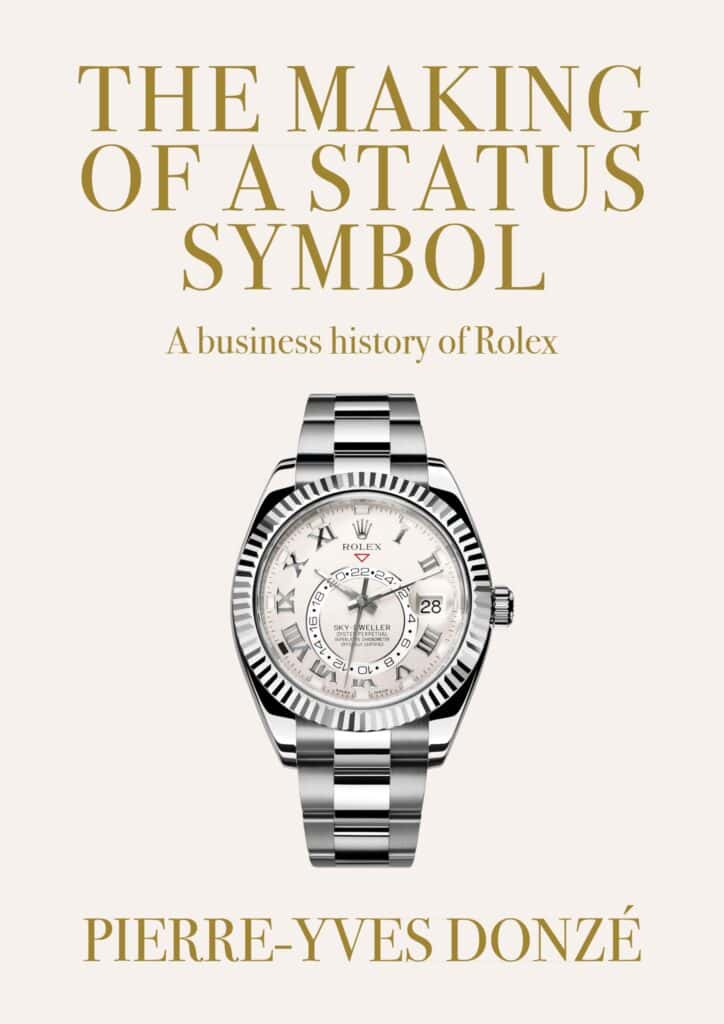The Making of a Status Symbol: A Business History of Rolex, by Pierre-Yves Donzé, offers a masterfully researched account of how Rolex evolved from a technically minded Swiss manufacturer into the global synonym for luxury and achievement. Donzé, Professor of Business History at Osaka University and a specialist in the Swiss watch industry, dissects the brand’s ascent with academic precision but delivers insights that will intrigue collectors and brand historians alike.
Although not officially authorised by Rolex, Donzé’s aim is clear, to uncover how the company built not merely a product, but an enduring symbol of success. At the heart of Donzé’s thesis lies a compelling observation — Rolex stopped talking about its watches and started talking about the people who wore them. This subtle shift, executed through pioneering marketing and storytelling, transformed Rolex from a respected watchmaker into a cultural icon.
Part I – Swiss Technical Excellence (1900–1945)
The opening section charts Hans Wilsdorf’s early vision, from his partnership with Alfred Davis in London to his insistence on precision, patents, and brand protection — principles that would define Rolex for decades. At the time, London was not only a major market for Swiss watches but also a launchpad into the Empire’s global trade networks.
Donzé traces Rolex’s early innovations in chronometer standardization and the company’s early embrace of modern marketing through collaborations with agencies like J. Walter Thompson (JWT) and De Garmo. By the 1930s, Rolex had already begun repositioning itself from a purely technical brand to one associated with social aspiration — a narrative that would later become its defining strength.
Part II – The Creation of Icons (1945–1960)
The post-war years marked a decisive turning point. As Switzerland emerged as the undisputed leader of global watchmaking, Rolex launched a string of enduring models — the Datejust, Submariner, and Cosmograph Daytona — that still define its catalogue today.
Donzé highlights the brand’s growing partnership with JWT, which helped craft the aspirational language of Rolex ownership. The watches were no longer just instruments of precision; they became emblems of personal success. For collectors, this section provides valuable context for how the Rolex “tool watch” became inseparable from notions of luxury and accomplishment.
Part III – Embodying Individual Success (1960–2020)
The final section follows Rolex’s evolution after Wilsdorf’s death, through the transformative leadership of André Heiniger. Under Heiniger’s stewardship, Rolex solidified its identity as the prestige watch brand — quietly consistent, globally unified, and remarkably resistant to industry turbulence.
While many rivals faltered during the quartz crisis, Rolex’s steadfast focus on brand image, continuity, and institutional discretion allowed it not only to survive but to dominate. Donzé’s analysis of internal communications between Rolex and JWT — including rare meeting notes — provides a fascinating glimpse into how campaigns featuring ambassadors such as Arnold Palmer, Nancy Lopez, and Jean-Claude Killy helped define Rolex’s modern mythos.
Donzé also examines Rolex’s measured adaptation to contemporary challenges — globalization, shifting consumer expectations, and the rise of digital communication — all while maintaining its uncompromising commitment to heritage and control.
A Collector’s Perspective
What sets Donzé’s book apart is its scholarly rigor. Drawing on extensive primary sources from the Musée international d’horlogerie and Swiss Federal Archives, the author situates Rolex’s story within the larger context of 20th-century business evolution and luxury branding.
That said, collectors may wish for more visual depth. The book’s monochrome illustrations, while informative, do little to capture the visual allure of the pieces discussed. A richer photographic component — particularly in colour — would better complement the depth of Donzé’s analysis and justify the hardcover price tag.
Still, The Making of a Status Symbol remains an essential read for anyone fascinated by how Rolex became Rolex — a story of precision turned into prestige, and a business case study that every serious collector should have on their shelf.
PRICE: £85.00 (hardcover)/£20.00 (paperback)
ISBN: 9781526183262/9781526188410
PUBLISH DATE: JUN 2025
PUBLISHER: MANCHESTER UNIVERSITY PRESS
Print length: 272 pages
Item weight: 322 g
Dimensions: 21.6 x 1.46 x 13.8 cm
About the Author

Pierre-Yves Donzé (born 1973 in La Chaux-de-Fonds, Switzerland) is a historian and professor specialising in global business history. He studied in Switzerland (Gymnase de Porrentruy, University of Neuchâtel, University of Lausanne) and earned his PhD in Letters and Humanities from Neuchâtel in 2005, writing on the history of Swiss hospitals (1840-1960).
Afterwards he held research and teaching posts in Switzerland, the United States, and Japan. In 2012, he became associate professor and a “Hakubi Scholar” at Kyoto University. Since 2016-2017 he has been Professor of Business History at the Graduate School of Economics, Osaka University. He is also a visiting professor at the University of Fribourg (Switzerland) and EM Normandie Business School (France).
His research interests cover the history of industries (especially the Swiss and Japanese watch industries), creative industries (fashion, luxury), multinational enterprise, the business history of medicine and health systems, and global competition. Honours include the Prix Gaïa (History-Research category) in 2011, in recognition of his work on horology and industrial & social history of watchmaking.
He has published numerous books and edited volumes in several languages (English, French, Italian, Japanese). Notable works include Histoire de l’industrie horlogère suisse: de Jacques David à Nicolas Hayek (1850-2000); Making Medicine a Business: X-ray Technology, Global Competition, and the Transformation of the Japanese Medical System, 1895-1945; Industries and Global Competition: A History of Business Beyond Borders.
For more information please visit Manchester University Press


